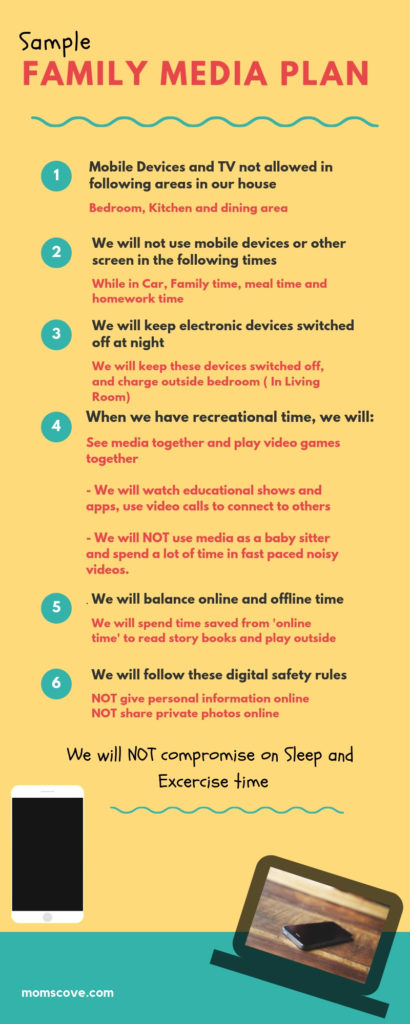
We realize that technology is an integral part of our lives but it is a double-edged sword. It has tremendous potential to help and improve learning experiences but if not used properly, it threatens to rob the child of important developmental skills. As parents, we understand that mobile phone overuse and excessive TV viewing can cause a lot of damage. But how to prevent your child from becoming a mobile phone addict? A family media use plan could be the answer. American Academy of Pediatrics recommends the use of a family media use plan as a part of their recommendation on media use in children. This is a plan that exposes children to media yet instigates checks and balances that in turn introduce restrain and teach safety.
Following are the broad aspects of creating a media use plan.

1. Define Screen-free zones in your home
Have some screen-free zones in your home. You can earmark certain areas of your home where any screen devices are not allowed.
The top suggested areas are the bedroom, kitchen, and dining area.
Do not put a television set in these areas. Also, keep them ‘phone-free zones’. It may be advisable to keep your cell phone out of the bedroom. Incoming messages and calls can disturb a child’s sleep. Light emitted from a charging device may also affect the quality of sleep. Keeping the screen out of the dining area allows your child to enjoy the food, develop a good eating habit, and offers you good family time. The use of mobiles during mealtime has been associated with obesity.
via GIPHY
These are some suggested areas. You may make plans of your own as per your requirement.
2. Define some Screen-free time:
It is important to earmark some ‘time’ as Mobile phone and TV free time. Keep all electronic screen devices off-limits at a particular time- Mealtime and Bedtime are important but in itself not enough. Longer screen-free time is required so that the child gets enough time to play, interact, and exercise (read jump around). Some suggestions are-
- In the car (except for long trips)
- during family time
- mealtime
- one hour before bed
- while in a stroller
- while crossing the street
- while at school or doing homework
- while driving (adolescents)
However, it is important to remember that the defined screen-free time is for the family and not just for the kid. Parents have to lead by example.
Turn off devices at night (if feasible)
Every family is different. But if it is feasible to turn off electronic devices at night in your family then that will be great. If you have an alternate communication channel (like a landline) and if you do not expect calls at night then you may consider switching off all mobile phone devices at night. If you expect some urgent calls at night and you feel it’s not practical to switch off the mobile, then keep one phone on (just in case!) and put off the rest. You can switch off the devices and put to charge in an area outside the media-free zones (out of the bedroom if feasible)
3. Diversify, but Choose Carefully
Different types of media have different advantages and benefits. Therefore you need to diversify the content that your child views. Keep your child’s list of media limited yet diverse. Choose from a variety of informative, educational, and recreational media available. But, it’s a sea out there and it is difficult to pick up one thing to view. Here are some tips on picking media for your child.
- Use interactive media: use media that are interactive and have educational value. Being ” interactive” means your child needs to interact more, rather than just pushing and swiping.
- Choose media carefully: Out there lots of media are labeled as educational. But choose what you need for your child based on good reviews. You can get reliable reviews from organizations like common sense media on apps, games, and programs.

4. Set rules for recreational media use:
The two most important rules that you may adopt are:
a) Co-viewing:
Co-viewing encourages parent-child interaction and also encourages children to learn better
b) Co-Playing:
Apart from learning better, Co-playing screen games with children help parents to stay connected with their children and teens. It also gives the parent an idea as to how your child is spending his or her time.
Apart from that, the following points are also important in choosing recreational media use:
Desirable
- Use educational shows or apps with reliable reviews
- Use media to connect to others, like video calls
Avoid or limit
- Avoid fast-paced shows with lots of bells and whistles ( These types of shows may make it harder for children to concentrate later)
- Don’t use Media or a screen device like a babysitter
- Limit background media (eg. TV running in the background as you spend family time)
5. Balance online and offline time
There is no denying that the appropriate use of media has a lot of potential for learning. But it is not uncommon to see children get buried into these smartphones or other screen devices and not even have time to look up to your face and give a smile or say hello! Manners are as important as it always has been and having a smartphone in hand cannot be an excuse to forget your manners. Therefore more face-to-face interaction with people is required to learn social skills and etiquette. Moreover, the loss of face-to-face time of children with their family, friends, and teachers can be catastrophic as this is so very important for learning and the normal development of the child. Keep face-to-face time as a prime priority; don’t let it get lost in the stream of media frenzy, or get blown away in the technology tornado.
Decrease screen time and use the saved time in
- reading books and going to the library
- Playing outside and playing with friends
- engage in imaginative play
- playing with blocks legos and puzzles
- being and interacting with family (helps improve emotional intelligence and have fun activities)
6. Teach children to become good digital citizens
Apart from being a citizen of our country, we are fast becoming digital citizens of the cyber world also commonly referred to as netizens. As it is important to be a good citizen of our country, it is also important to be a good citizen of the cyber world. It is vital to talk about issues like cyberbullying and identify it early if your child is a victim, as it can affect the mental health of your child. Promptly take the child off the social media or the digital platform where bullying occurs.
via GIPHY
7. Safety first: Teach Digital and Cybersafety
The digital environment can be as risky (sometimes even riskier) as the three-dimensional world around us. So we must be teaching digital safety to our children in an age-appropriate manner.
Teach and follow these digital safety rules:
- Do not give out personal information online (including financial details)
- Do not share private photos online
- Review the privacy settings of all sites with your children (especially older children )
You can use the American Academy of Pediatrics powered website to create a Personalized Family media use plan.
Hope you have liked the article. Don’t forget to share the article among your friends and leave a comment below if you have some more pragmatic ideas worth sharing with the world!
Leave a Reply